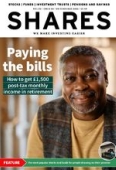Archived article
Please note that tax, investment, pension and ISA rules can change and the information and any views contained in this article may now be inaccurate.
How compounding works in investing and why it is important

The more experienced investor
This is the first in a series of articles aimed at building your knowledge if you have at least some experience of investing. Look out for the next part in the series in a future issue of Shares.
Compounding is a term which gets bandied about a lot in the investment world, but it can be a tricky subject to understand. This article explains why it is important to investing and how it works.
Conceptually, James Dow of Baillie Gifford and co-manager of the Scottish American Trust (SAIN), known as SAINTS summed compounding up very well when he likened it to the effect of a snowball rolling down a long hill: ‘The further it travels, the faster it gains in size.’
REINVESTING INCOME IS KEY TO COMPOUNDING
Let’s break down the mechanics of compounding to understand its relevance and importance to investing.
When an investment is made into a cash savings account or dividend paying stocks and shares, it will eventually lead to a decision about what to do with the income received.
It is the reinvestment of income which lies at the core of compounding.
A simple example will show the effects of reinvesting compared with not reinvesting.
Let’s say Jane and John each buy 200 shares in food retailer Sainsbury’s (SBRY) at a price of 245p. The company pays a dividend of 12.6p per share equivalent to around £25 in hard cash, representing a yield of 5% (12.6p divided by 245p multiplied by 100).
Jane elects to reinvest her dividends while John takes the cash. Before reading any further, take a moment to guess what difference this might make to their relative wealth over 20 years.
The first cash dividend will buy another 10 shares, so in year two Jane now owns 210 shares. Let’s also assume the company increases the dividend by around 5% a year. So, in year two the dividend paid is 13.2p per share (12.6p multiplied by 1.05).
That means in the second year the payout will be £27.70 (210 shares multiplied by 13.2p).
If the shares remain unchanged at 245p, Jane’s shares will be worth around 11% more than when she started. For the rest of the illustration, we will assume that the share price rises in line with the growth in the dividend, at 5% a year.
As the table shows after 20 years Jane’s investment would be worth £3,383 or roughly seven times her original £490 investment into Sainsbury’s. This works out at a compound annual return of 10% a year. The original investment is doubling roughly every seven years.
However, John didn’t get a compounding benefit so his 200 shares would only be worth £1,300 (650.1p multiplied by 200). In the intervening period he would have received dividends of 416p, totalling £833 (416p multiplied by 200 shares). The total value of his shares plus dividend income is therefore £2,133.
Meanwhile Jane has been able to purchase 320 new shares (more than doubling her original holding) with cash provided by the company to boost or compound her total investment return.
The effect of compounding the dividend income into new shares has resulted in Jane accumulating £1,250 (£3,383 minus £2,133) more wealth than John in this hypothetical example. This is a difference of around 60%. How close was your guess?
Important information:
These articles are provided by Shares magazine which is published by AJ Bell Media, a part of AJ Bell. Shares is not written by AJ Bell.
Shares is provided for your general information and use and is not a personal recommendation to invest. It is not intended to be relied upon by you in making or not making any investment decisions. The investments referred to in these articles will not be suitable for all investors. If in doubt please seek appropriate independent financial advice.
Investors acting on the information in these articles do so at their own risk and AJ Bell Media and its staff do not accept liability for losses suffered by investors as a result of their investment decisions.

 magazine
magazine








